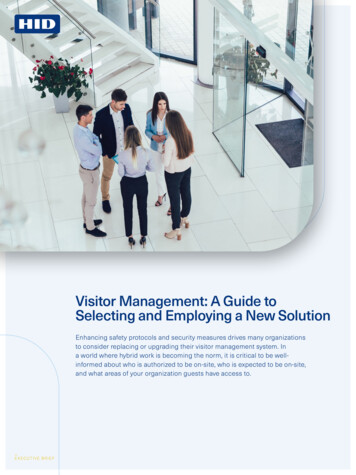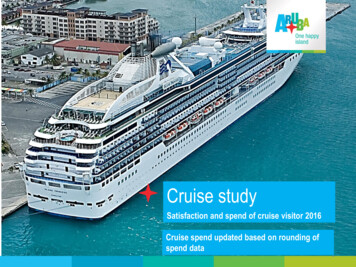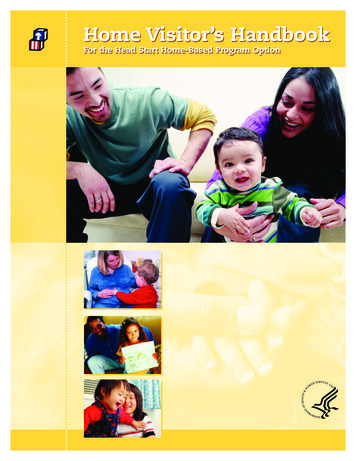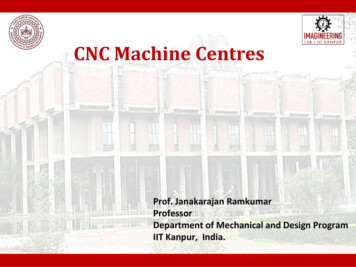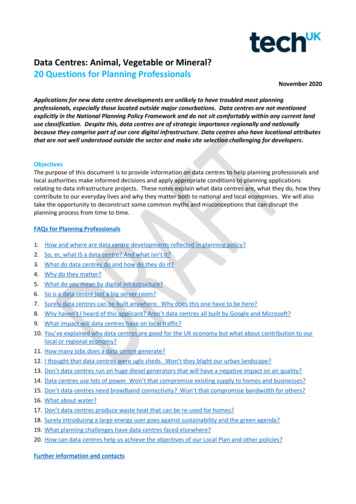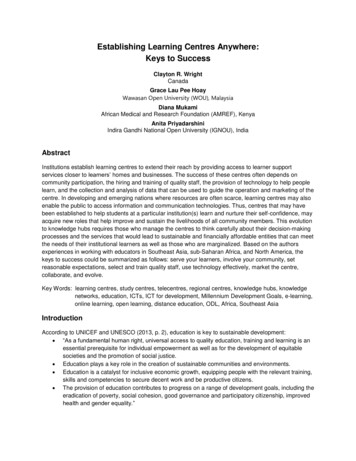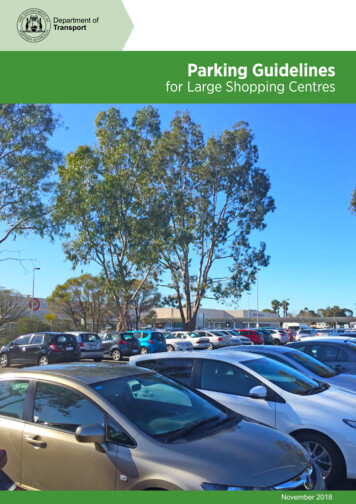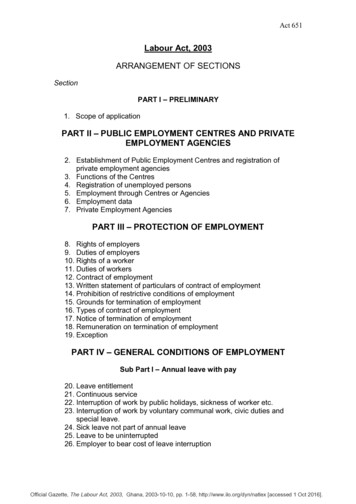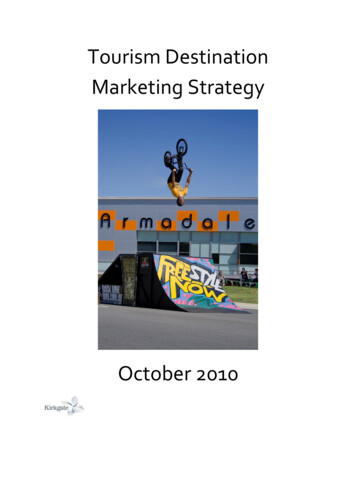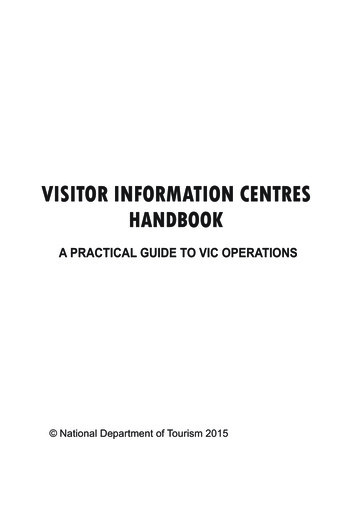
Transcription
VISITOR INFORMATION CENTRESHANDBOOKA PRACTICAL GUIDE TO VIC OPERATIONS National Department of Tourism 2015
TABLE OF .17.27.37.47.57.67.77.8a.b.8.8.18.29.About Visitor Information Centre’sOverviewOperations and AdministrationMaintenanceBrochure RacksDisplay CabinetsImportant Contact NumbersAssets RegisterKey RegisterRecord keepingSafety ProceduresDaily VIC Operations ChecklistOpening and Closing ProcedureDatabase ManagementCapturing of StatisticsService ProvisionUniform/Dress CodeStaff/Shift Roster (Operations)Application of the Batho Pele (People First) PrinciplesService DeliveryEvents CalendarWeather FocusCurrency updates for major currencies e.g. ; ; US ; Handling of ComplaintsTouristsVIC OfficialsBrandingCollateralSignageCapacity 3436373839VISITOR INFORMATION CENTRE
1. ABOUT VISITOR INFORMATION CENTRESA Visitor Information Centre (VIC) is a physical location that providestourist information to visitors who tour in the vicinity of the place orarea and they are usually located within the municipal area. VICs playan important role within the tourism industry, as they serve as vital firstpoints of contact and provide value-adding services to visitors.Visitor Information Centres can either be privately owned orGovernment owned. Privately owned VICs are directly owned andrun by the local community through an organisation separate from theofficial (local) governmental institutions of the area, but with the fullknowledge and sometimes even funding from relevant (local)government institutions. The government owned VICs are owned bya municipality and get funding for daily operations from themunicipality.Tourists perceive Visitor Information Centres (VICs) as important inthe provision of tourist services at the destination. The maininformation they need relates to attractions, timing and travelinformation. Modern tourists prefer a combination of traditionalsources of information in a form of written information (brochures),verbal information (face-to-face) as well as electronic information(Internet, Cell Phone Applications etc.). However, there is a growingtrend in travellers using the Internet as a source of information and tomake reservations for various tourism products e.g. accommodation,car hire etc.1VISITOR INFORMATION CENTRE
2. OVERVIEW OF THE HANDBOOKThis handbook serves as a guide for VICs' daily operations andsupplements the VIC's operational policies and/or procedures. AllVICs are expected to comply with a range of Local, District andProvincial government legislations and regulations as well as otherstandards, rules and regulations laid down by sector bodies andlegislation. This handbook covers the key areas of VIC operation thatmust be taken into account as part of day-to-day operationalprocedures at a VIC.The handbook is merely an operational guide which will assist withinteracting with visitors as well as improving the overall approach tomanaging the VIC. It serves as guide and does not seek to replaceany existing legislation or organisational policy. At best, it directs VICofficials on how best to run a VIC from an operational point of view andfocuses on three aspects mainly, the day-to-day operations, serviceprovision and capacity building. There is a need for VICs to operate ina standardised manner across the country, as this adds value in thegrowth of the tourism sector and further benefits the economy of thecountry.This handbook covers the following key aspects of a typical VIC'soperational requirements and procedures:·Operations – operations have to do with the carrying out of dailyduties that are required for a VIC to be fully functional. One of thekey sections is the operational checklist that the VIC officials needto use on a daily basis.2VISITOR INFORMATION CENTRE
Opening and closing procedures – these procedures arenecessary to apply at all VICs as a good practice and to alleviateincidents of unauthorised entry to the VIC after hours. Key to thissection is the graphic presentation of routine opening and closingprocedure.Database Management – the management of a database oftourism products and membership is a backbone of a VIC andshould be done professionally.Reporting – all VICs are expected to compile reports on a monthly,quarterly and annual basis. In some instances, the reporting couldbe done on a weekly basis and should cover the capturing andanalysis of statistics.Service provision and the principles of Batho Pele (People First) –this section summarises the key aspects of what a VIC officialshould do in order to provide excellent customer service and alsopresents a graphic illustration of the principles of Batho Pele. Thissection also outlines some of the best methods on how to goabout handling complaints.Branding – the section on branding alludes to the need for VICs topromote a unified VIC brand that sells the South Africa tourismsector brand. The National Visitor Information CentresFramework developed by the Department of Tourism providesmore insight on the need for unified VIC branding and is availablefrom the department. This VIC Operations Handbook ends byhighlighting the need for all VICs to capacitate the VIC officialsthrough identifying the skills gap and implementing the correcttraining interventions. It also highlights the need for VICs tocomply with indemnity requirements in order to prevent legalitiesarising from services provided by the VIC.3VISITOR INFORMATION CENTRE
4VISITOR INFORMATION CENTRE
OPERATIONS ANDADMINISTRATION5VISITOR INFORMATION CENTRE
3. OPERATION & ADMINISTRATIONFor the purpose of this handbook, operations refer to day-to-dayactivities that the VIC officials are required to carry out in order for theVIC to fulfil its mandate of providing tourism services to the visitor. Thecarrying out of activities entails administrative and other functions thatensure that the VIC functions like any other organisation. Below aresome of the generic aspects of a VIC that require attention on dailybasis or as regularly as the VIC management finds necessary.3.1 MaintenanceCustomers equate the image and appearance of a VIC with thequality of service and advice they will receive. Workstations and officeconditions should be checked on a regular basis, to ensure they arewelcoming to the customer and it lives up to the expectation. Thechecklist provides an example of an operational checklist that mayassist the VIC official to note or customise. The purpose of thechecklist is to ensure that the VIC is ready before the doors areopened for business. The physical condition of the VIC should bemonitored throughout the year, to ensure that it remains neat and tidyall the time. In essence, it is every official's responsibility to ensurethat the VIC looks clean, neat and tidy all the time.···Entrance: should be kept swept and tidy on a daily basis.Windows: should be kept clean, especially the glass of thefront door.Carpets: should be vacuumed regularly and mats shaken ondaily basis.6VISITOR INFORMATION CENTRE
3.2 Brochure RacksDepending on the size, location and visitor traffic, a VIC requires adedicated space for brochure display. The brochure racks should bedivided into categories of information and/or regions to make it easierfor visitors to get the kind of information they require. A VIC isexpected to and should have free easy-to-use tourist maps of thelocal town/area including nearby attractions as a minimumrequirement. Regional and national maps may be for sale if deemednecessary. VICs in the same region should also standardise theirmaps to ensure that the tourist receives the same information nomatter from which VIC the map is collected from.Display of the Brochure Rack7VISITOR INFORMATION CENTRE
3.3 Display CabinetsThe layout, décor and VIC personnel should be able to create anappealing ambiance for anyone visiting the VIC to feel comfortableenough to interact and enjoy the features of the VIC. This wouldinclude ensuring that the display cabinets are kept neat and tidy andfully stocked, should a VIC be selling merchandise; the price tagsshould be displayed in a manner that is easy for the visitor to read.3.4 Important Contact NumbersInformation Officers should be able to provide tourist with a list ofrelevant important contact numbers which they might require duringtheir stay in South Africa. Here is a list of important contact numbersthat the traveller may need in the case of an emergency; SAPS;ambulance service, rescue service (aviation), medical rescue3.5 Assets RegisterThe VIC needs to know the details and value of each individual item itowns. This information is required for assets control purposes, as wellas insurance and scheduling of maintenance and replacement. Asummary of each item should be listed on an assets register of theVIC. It is the VIC management's responsibility to have a system inplace to update the assets register on a regular basis. Each timeequipment is purchased it is entered on the assets register in e.g. thefollowing categories: Furniture and Furnishings for both office andshop (for VICs with curio shops); Individual items over R300.00 invalue (e.g. office equipment) etc.8VISITOR INFORMATION CENTRE
VERIFICATION OF ASSETS/FURNITURE AND OFFICE EQUIPMENTItem Description Barcode Qty Purchase Warranty Purchase ProjectedDateCostReplacemNameent DateDesk With 3Drawers23668 123/04/14 1 year R6 200 5 years23669 1 23/04/14 1 yearChair Black,RecliningR1 900 5 yearsTable 1: Example of an assets register templateBelow is a list of aspects to consider for a register per each item:· Item name;· Number of items or grouped items;· Purchase date (ddmmyyyy);· Description;· Model ID;· Serial number;· Special features;· Purchase cost - with column total (x);· Supplier;· Full contact details;· Warranty period and expiry date;· Replacement date (ddmmyyyy);The register is used to help aspects of budget planning. In particular,the budget needs to provide for the replacement of equipment.9VISITOR INFORMATION CENTRE
3.6 Key RegisterA key register for the VIC is used to record the names and contactdetails of all personnel with the responsibility of handling the VICkeys. Key registers are necessary for VICs that have more than oneofficial responsible to open and/or close the VIC in order to ensureaccountability and control. Keys should also be numerically identifiedand cross-referenced within the register. The register should bereviewed on a regular basis. In the event of a lost key the VICmanager will be responsible for replacing all locks that are affected bythe lost key. The purpose of the key is to prescribe the control, useand possession of keys at the VIC in order to ensure an appropriatelevel of accessibility, security and protection is afforded to tourismofficials, assets, property and facilities.KEY REGISTER - EXAMPLETshwane Visitor Information CentreOfficial’s Position Key AccessNumb- ToNameerJohn InfoSmith OfficerDateIssuedRecipient AuthorisSignature ingSignatureMY234 Storage 25/07/2014 Signature SignatureJacob Supervisor MY234 FrontBushDoor25/07/2014 Signature SignatureTable 2: Example of Key Register10VISITOR INFORMATION CENTRE
3.7 Record-keepingRecord-keeping forms part of mandatory administrative functions forany organisation and VICs are also expected to do the same. The VICshould at all times ensure that all transactions taking place at the VICare recorded and a systematic audit of business transactions takesplace on regular basis to ensure compliance with good businessmanagement practices. The transaction record-keeping shouldinclude all documents that are relevant for the purpose of ascertainingthe business's income and expenditure. Records should be kept for aminimum of five years from the date of transaction. There are variouskinds of records that are to be kept and for the purpose of the VIC therecords that should be kept may include although not limited to thefollowing:···financial records;staff records;visitor statistics;visitors book.11VISITOR INFORMATION CENTRE
3.8 Safety ProceduresVICs need to comply with the Occupational Health and Safety (OHS)regulations and should have a valid OHS certificate all the times. VICsform part of the workplace and need to comply with the OHSrequirements for VIC officials and the public or tourists who visit thefacility and therefore they have an obligation to comply with theworkplace, health and safety issues. The VIC should develop,implement and maintain occupational health and safety systems,policies, procedures and standards that will minimise work relatedinjuries and illness and provide safe work facilities and equipment;including the resources and training necessary to assist inmaintaining a safe work environment.The measures should cover but not limited to the following aspects:how to raise an emergency alarm;who the emergency security contact person is;location of emergency exit/escape doors and procedures;where to assemble in the case of emergency and evacuation;emergency evacuation charts should be prominently displayedwithin the VIC.12VISITOR INFORMATION CENTRE
3.9 Daily VIC Operations ChecklistChecklists communicate a variety of information from work goals andproject objectives to people's ability to organise and communicateinformation. The daily VIC checklist is not hard and fast rules to liveby; they are guidelines to help the VIC maintain consistency whenassisting tourists and to ensure that every experience at thatparticular VIC is a good experience.One of the underlying reasons for using the checklist is to preventmistakes. The Operational Checklist that is to be implemented at thestart of every day. This Operational checklist will be checked bytourism officers and signed and dated by either the VIC manager or acolleague. Should it be found that the Operational Checklist was notimplemented correctly the person that conducted the check as well asthe witness that signed that all is in order will be held responsible forany inconvenience caused as a result. Below is an example of achecklist that can be used at a VIC. Please note that this is just a guideand each VIC may be unique and therefore may have more or less oreven different items depending on what it has as part of the inventoryand/or assets.13VISITOR INFORMATION CENTRE
OPERATIONAL CHECKLISTS (FRONT PAGE)MONTUEWEDTHU FRI SAT SUNBrochuresDisplay racks are neatand fully stockedMember brochures are ondisplay (neat and fullystocked)All commissioned operatorbrochures in stock and ondisplay(where applicable)All brochures/promotionalmaterials are currentFlyers displayed neatlyBrochures displayedvertically for visualimpact and neatnessOnly the officaillyauthorised materialare on displayEquipmentAll terminals operationalprior to the commencement of the shiftPrinters,Fax,Copier etcall working clear of clutterand neatly placedCords & Cables are neattidy safe and not frayed14VISITOR INFORMATION CENTRE
OPERATIONAL CHECKLISTSMONTUEWEDTHUFRISATSUNDisplaysClean and tidy, not fadedor tatteredOnly up to date materialis displayedDisplays are in accordancewith OHS requirementsNo sharp edges, nocords or wire protrudingAll displays prices/info areclearly visible at eye levelWork StationsClear and uncluttered - nostuffed toys, fluffy animalson computersNo unnecessary stickersnotes on computers and/or desksNo company confidentialinformation on publicdisplay at anytimeWhere possible desks areto be kept clear of filesPersonal property to bekept safe and not left ondesk topsTable 3: Example of operational checklist15VISITOR INFORMATION CENTRE
16VISITOR INFORMATION CENTRESIGN:WITNESS: AME:SATSIGN:DATE:NAME:SUNWITNESS: WITNESS : WITNESS: WITNESS:SIGN:DATE:NAME:THUTable 4: Example of VIC operational checklist (back page)SIGN:DATE:DATE:DATE:NAME:WEDNAME:TUENAME:MON
OPENING ANDCLOSING PROCEDURES17VISITOR INFORMATION CENTRE
4. OPENING & CLOSING PROCEDURESDepending on the VIC setup and requirements, certain proceduressuch as opening and closing the VIC at the beginning and end ofbusiness may need to be applied on a daily basis. In essence theprocedure is designed to describe 'Who', 'What', 'Where', 'When', and'Why' by means of establishing corporate accountability in support ofthe implementation of the procedure. Procedures are importantbecause they are the strategic link between the VICs vision and theday to day operations. Written procedures enable employees tounderstand their roles and responsibilities within defined limits. Thisalso allows management to guide operations without constantmanagement intervention.18VISITOR INFORMATION CENTRE
1Arrive at work15 minutesbefore openingtime10Set the alarm,lock door andcheck out2Unlock thedoors and disarmalarm3Turn on lights,fans, computersand photocopiers9Check that alltourists have leftand ensure all doorsand windowsare secure4Run through theoperationalchecklist8Turn offcomputers,photocopiers,fans and lights57Lock doors andcomplete lastcustomerenquiries withpatience6Open doorsand SMILETidy up thecounter, brochureracks, displaysFigure 1: Opening and Closing procedures19VISITOR INFORMATION CENTRE
DATABASEMANAGEMENT20VISITOR INFORMATION CENTRE
5. DATABASE MANAGEMENTData and information management is the development of policies andsystems that protect and deliver the information that the VIC needs inorder to operate. In-depth data and information management iscrucial to the success of any VIC and should always be a priority.When data is inaccurate, inaccessible, lost, or incomplete, the VICcan suffer from financial losses, missed opportunities, lowproductivity, and a poor reputation. To assist the VIC with managing itsdata and information more effectively, as a team list the frustrationsand inefficiencies that are experienced. Then, review the risks thatyou need to protect against. When the changes that need to be madehave been identified, assistance can be requested from ITprofessionals about these issues and find out what you can do tostreamline processes and systems within the VIC.There are various kinds of databases that can be developed forcapturing. The kind of database that you create will depend on whatinformation you require and what you will be doing with that capturedinformation.To keep a proper database, a decision has to be made on the type ofdata that will be kept. This will ensure that the management of thedatabase does not become complex and that the duplication of data iseliminated. This can include the number of visitors that visit the VIC,the period of high visitor turnout and also the questions that arefrequently asked. All these data stored in a proper and reliabledatabase will assist management in decision making. Furthermore,there should be in place a backup and recovery strategy that would beused in case of data loss.It should be the responsibility of each VIC to ensure that theinformation contained in the databases are be kept relevant. The21VISITOR INFORMATION CENTRE
information can be updated on quarterly basis by consulting with theappropriate data custodians.22VISITOR INFORMATION CENTRE
EXAMPLE OF DATABASE CATEGORIESDATABASEDESCRIPTIONAccommodation A database that contains accommodationestablishments in the nearby area.Preferably only graded establishmentsTour OperatorsA list of registered Tour Operators that couldassist with getting cheaper rates for bookingsTour GuidesA list that contains all registered tourist guidesin the provinceAttractions andActivitiesLocal attractions and activities that the touristwill enjoyTourism Office / A list of contact information for all tourism officesin the surrounding areaVICsTransportationContact information for local shuttles, tour bussesand taxis etcEventsA database of events taking place on a monthly basisEmergencyContact information of hospitals, fire stations,disastermanagement,doctors etc in the regionEntertatinmentA list of family friendly places that can be visited aswell as night life establishments that can be enjoyedTable 5: Example of VIC Database categories23VISITOR INFORMATION CENTRE
CAPTURING OFSTATISTICS24VISITOR INFORMATION CENTRE
6. CAPTURING OF STATISTICSStatistics is the study of numerical information, which is called data.Statistics are used as a tool to understand information. Learning tounderstand statistics helps to react intelligently to statistical claims.Statistics capturing are a mandatory function of a VIC, as it informsdecision-making but more than anything, is it keeps the VIC officialsmake informed decisions about the achievements or lack of thereof.When reporting on statistics the key reporting areas could includewhere the tourists are coming from; the current province that the VICis located in; what information did they require from the VIC etc. Thereporting frequency may vary from VIC to VIC but monthly, quarterlyand annual reports are often a norm across organisations. The visitorstatistics component of the report may be made available to thestakeholders on request, as it would assist in decision-makingStatistics are a planning tool that helps to forecast the future. All VICsare required to have a credible visitor statistics capturing system inplace and be used consistently. The system should be able to capturethe numbers and profiles of all visitors for analysis, reporting anddecision-making purposes and the statistics should be analysed on amonthly, quarterly and annual basis and be made available tostakeholders on request. The monthly data will serve as the basis forestablishing visitor patterns during tourism seasons. The capturing ofvisitor statistics at a VIC is mandatory, as it assists in decision-makingand can be very helpful in determining tourist trends. The fields ofdata that will be captured for statistical purposes will be determined25VISITOR INFORMATION CENTRE
VISITOR INFORMATION CENTRETOWNStaff Name:Staff Name:Staff Name:06H00 - 14H0014H00 - 22H0009H00 - 17H0021Table 6: Example of Visitor Statistics Capturing TemplateTOWN)ACCOMMO- TRANSPORTENTRYNO.TOURSBROCHURE ATTRAC- SEX EVENTS OTHERNUMBER PEOPLE DATION(PROVINCE/ (PROVINCE/ (PROVINCE/ TIONS(FM)PROVINCETOWN)TOWN)TOWN) (PROVINCE/Month:VISITOR STATS CAPTURING TEMPLATEby the managing authority of the VIC. Below is an example ofimportant data that a visitor statistics form should capture26
SERVICE PROVISION27VISITOR INFORMATION CENTRE
7. SERVICE PROVISIONVICs are key contact points for a tourist and assuch, play an important role in promoting thelocal, regional and countrywide tourismproducts. For the tourist, a VIC is a one-stopresource where he/she expects all relatedtourism queries to be answered satisfactorilyand anything offered over and above what thetourist had been expecting goes a long way increating a lasting impression about thedestination. A VIC also provides a goodopportunity to showcase and promote thetourism sector's niche products such asculture and heritage, mega events and otherauthentically African tourism products that thecountry has to offer.In cases where the VIC has an opportunity togenerate income, this can present anopportunity for the VIC to sell merchandisefrom the facility thereby supporting tourismbusinesses. The VIC is also the face of thetourism sector and should always strive tomeet the minimum expected standards ofservice excellence in order to help inpromoting return visits to the destination. It isstrongly recommended that all VICs are28VISITOR INFORMATION CENTRE
manned by not only qualified officials who are driven by passion forservice excellence – officials who have an intuitive drive to go an extramile in service excellence. The VIC should always strive to offer thebest service that can be offered within its capability.The general principle in service excellence has to do with achievingthe level of standards accepted as being above the ordinary servicethat a typical tourist would receive at any VIC. In order to achieveservice excellence each VIC should have benchmarks from what theofficials consider to be minimum standards of service to what isconsidered to be average service and what is considered to be aboveaverage service and subsequently what is deemed to be outstandingservice. There are different kinds of principles that should be put inplace in order to achieve service excellence. Below is list of some ofthe guidelines applicable.7.1 Uniform CodeIt is advisable that each VIC has a uniformed dress code to ensurethat, in carrying out their daily duties, all the VIC officials look the part.The dress code includes wearing name badges. Suggestions for thedress code or uniform include branded clothing items of the samecolour are worn by all VIC officers.7.2 Staff/Shift Roster(Operations)In VICs that operate longer than normal business hours requiring shiftwork, it is advisable that rosters are prepared on a monthly basis andshould be made available to the VIC officials well in advance. This willenable the officials to familiarise themselves with the requirementsbeforehand. Rosters can be posted in areas where they are easilyaccessible to the officials.29VISITOR INFORMATION CENTRE
VISITOR INFORMATION CENTRERoster: March 20152345678Mon 14h00-22h00Tues 14h00-22h00Wed 14h00-22h00ThursOFFFriOFFSat 06h00-14h00Sun 06h00-14h00Weekly HoursMon 06h00-14h00TueOFFWed 06h00-14h00Thu 06h00-14h00FriOFFOFFSatSunOFFWeekly HoursMon 14h00-22h00Tue 14h00-22h00Wed 14h00-22h00Thu 14h00-22h00FriOFFSat 14h00-22h00Sun 14h00-22h00Weekly HoursMon 06h00-14h00Tue 06h00-14h00WedOFFThu 06h00-14h00Fri 06h00-14h00SatOFFSunOFFStaff Member ZStaff Member YStaff Member esOFFWed 06h00-14h00Thurs 06h00-14h00Fri06h00-14h00SatOFFOFFSunWeekly HoursMon 14h00-22h00Tue 14h00-22h00Wed 14h00-22h00ThuOFFFri06h00-14h00Sat 09h00-17h00Sun 09h00-17h00Weekly HoursMonOFFTueOFFWed 06h00-14h00Thu 06h00-14h00Fri 14h00-22h00SatOFFSunOFF02 Mon 06h00-14h00 83 Tues 06h00-14h00 88 4 Wed0OFF8 5 Thurs 14h00-22h00 814h00-22h00 88 6 Fri0 7 Sat 14h00-22h00 80 8 Sun 14h00-22h00 824Weekly Hours489989 MonOFF010108 10 Tue 06h00-14h00 811118 11 WedNDT812120 12 Thu 14h00-22h00 813138 13 Fri14h00-22h00 814148 14 SatOFF015158 15 SunOFF048Weekly Hours320 16 Mon 06h00-14h00 8161617170 17 Tue 06h00-14h00 818188NDT8 18 Wed191908 19 ThuOFF20208 20 Fri 06h00-14h00 821210 21 Sat 06h00-14h00 822220 22 Sun 06h00-14h00 8Weekly Hours24Weekly Hours482323 Mon 14h00-22h00 8 23 MonOFF02424 Tue 14h00-22h00 8 24 TueOFF02525 Wed 14h00-22h00 8 25 Wed 06h00-14h00 82626 Thu0 26 Thu 14h00-22h00 8OFF2727 Fri 14h00-22h00 8 27 FriOFF02828 Sat 09h00-17h00 8 28 SatOFF02929 Sun 09h00-17h00 8 29 SunOFF0Weekly Hours32Weekly Hours48Weekly Hours1630 Mon 14h00-22h00 8 30Mon0 30 Mon 06h00-14h00 8OFF31 Tue 14h00-22h00 8 31Tue 06h00-14h00 8 31 Tue 06h00-14h00 8Weekly HoursWeekly Hours168Weekly Hours16Total Number of Hours Worked 160 Total Number of Hours Worked 152 Total Number of Hours Worked160Public HolidayWeekendSplit Shift WeekendOff0N.B. You can swop shifts by arrangement with the a respective colleague but should confirm with the supervisor as well.Table 7: Example of VIC Operational Roster30VISITOR INFORMATION CENTRE
7.3 Application of the Batho Pele (People First) PrinciplesAlthough primarily meant for South Africa's Public Servants, thePrinciples of Batho Pele are applicable in customer serviceenvironments outside the government sector and are thereforerelevant because the majority of VICs across South Africa aregovernment-owned. The Batho Pele principles aim to enhance thequality and accessibility of government services by improvingefficiency and accountability to the recipients of public goods andservices. The eight principles are summarised as follows: regularlyconsult with customers; set service standards; increase access toservices; ensure higher levels of courtesy; provide more and betterinformation about services; increase openness and transparencyabout services; remedy failures and mistakes and provide the bestpossible value for money. These are summarised graphically below:31VISITOR INFORMATION CENTRE
32VISITOR INFORMATION CENTRE15THE PRINCIPLE:You should be given full, accurateinformation about thepublic services you areentitled to receive.You will get full, accurate and up-to-date factsabout services you are entitled to. Informationshould be provided at service points and inlocal media and languages. Contact numbersand names should appear in all departmentalcommunications.You’re entitled tofull particulars.INFORMATIONTHE PRINCIPLE: You should be consulted aboutthe level and quality of the public services youreceive and, whereverpossible, should be given achoice about the servicesthat are offered.You will be asked for your views on existingpublic services and may also tell us what newbasic services you would like. All levels of societywill be consulted and your feelings will beconveyed to Ministers, MECs and legislators.You can tell us whatyou want from us.CONSULTATION2637THE PRINCIPLE: If the promised standard of serviceis not delivered, you should be offered anapology, a full explanation and a speedy andeffective remedy. When complaints aremade, you should receive asympathetic, positive response.Mechanisms for recording any public dissatisfactionwill be established and all staff will be trained tohandle your complaints fast and efficiently. You willreceive regular feedback on the outcomes.Your complaints mustspark positive action.REDRESSTHE PRINCIPLE:You and all citizens should haveequal access to theservices to which youare entitled.Departments will have to set targets for extendingaccess to public servants and public services. Theyshould implement special programmes forimproved service delivery to physically, sociallyand culturally disadvantaged persons.One and all shouldget their fair share.ACCESSDesigned and issued by the Department of Public Service and Administration.THE PRINCIP
This handbook covers the following key aspects of a typical VIC's operational requirements and procedures: Operations - operations have to do with the carrying out of daily duties that are required for a VIC to be fully functional. One of the key sections is the operational checklist that the VIC officials need to use on a daily basis. ·
